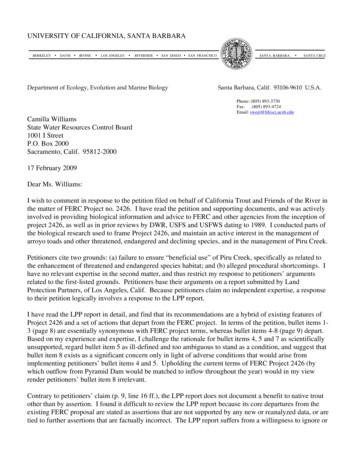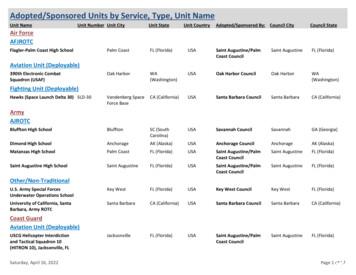UC Santa Barbara Session B Summer 2019s 12:30-1:50PM LSB
1st Zen Patriarch12:30-1:50PMLSB 1101BodhidharmaMind and Material PracticesZen BuddhismUC Santa BarbaraSummer 2019Session BPeterRomaskiewicz(roma-SKEV-itch)Office: HSSB 30552-3PMpmr01@ucsb.eduCourse DescriptionThis course will explore the history, literature, andpractices of Zen Buddhism as it developed in China,Japan, and in the West (especially the US). During ourexploration we will read Zen texts, ruminate upon Zenmyths, contemplate Zen art, listen to Zen music,examine Zen meditation, and analyze Zen objects.One of the lasting allures of Zen is its “mystical”character that derives from its own mythology. Zenoften proclaims that its own authority stems from itsnon-reliance on scripture, the very bedrock of theBuddhist tradition. Because of this positioning, it iseasy to view Zen as a tradition that abandons traditionalforms of Buddhist practice – but this would be amistake. To fully appreciate the history of Zen, we mustplace it within its proper monastic context and besideits numerous material practices. Thus, in addition tomyth, we will focus on Buddhist perspectives onmeditation and material culture and explore how theyconverge in the practice of Zen.As we can see, “Zen” has come to represent a lot ofthings. “Zen” is the Japanese pronunciation of Chinesecharacter meaning “meditation” 禪, pronounced chán.Aside from meditation, Zen also refers to its owndistinctive lineages, literary genres, and rhetoricalstyles. Historically, Zen has its origins in seventhcentury China, but it’s myths trace its origins to theBuddha in India. The tension between history and mythwill be a point of reflection in our course, and we willsee how this tension has driven the popularity of Zenuntil today.RomaskiewiczThe first portion of the course will be devoted toreviewing basic Buddhist concepts. These will beplaced in contrast to the significant culturaltransformations that occurred in China and Japan, thusresulting in creation of this elusive entity we call Zen.1Zen Syllabus 2019
Learning OutcomesAt the end of this course you will be able to:] Identify and describe principle beliefs, practices, themes, and contested issues in (Zen) Buddhism] Apply historical critical methods to explain the social or cultural forces that shape the different contoursof (Zen) Buddhism] Analyze and evaluate the claims regarding the mind and meditation practice in (Zen) Buddhism] Analyze visual and material objects related to (Zen) Buddhism for multiple layers of meaning] Communicate – and even debate – with your peers through in-class activities, out-of-class onlinediscussion forums, and through written assignmentsGradingAttendance & “Prep-ticipation” (10%) (23classes): Attendance and class preparation/participation is mandatory. The daily readings willprepare you for class engagement (discussion,surveys, peer review, & other activities) so take noteson what you read, including your thoughts on thecontent (GS Reflections, below, will help with thisprocess if this concept is new to you). Also, considerlectures and discussions as complementary to ourreadings, thus being prepared and willing to engagewith your peers (in small groups) are keys to success.Quizzes (10%) (4 total): At the start of every weekwe will have a “low-stakes memory challenge”covering the material from the previous week. Thesewill be online through GauchoSpace and completedat home before the start of the first class of that week.See GauchoSpace for more info.GauchoSpace Reflections (20%) (20 total): Theseare daily short responses to the assigned readings.They require you to assess what you found new, old,and odd (the 3Qs) for each reading, as well as areflection on a daily theme (1DT). Entries need to beposted on GauchoSpace before class each day; latework will not be accepted. You are allowed to miss amaximum of two reflections without gradingrepercussions. See GauchoSpace for extendedinstructions on 3Qs/1DT.Final Exam (30%): The in-class final will becomprehensive with a focus on the last three weeksof class. The exam will be multiple choice and shortanswer with a take-home essay component.Mid-Term Exam (30%): The in-class midterm willcover material from the first three weeks of class.The exam will be multiple choice and short answerwith a take-home essay component.Your Success Matters to Me!If you have a documented disability that affects your work in thisclass, the Disabled Students Program (http://dsp.sa.ucsb.edu/) willhelp you with arranging accommodations.“Zen Gardens” are actually known as kare-sansui, or “dry landscapes.” This famous example is at Ryōan-ji.Romaskiewicz2Zen Syllabus 2019
MotivationsPeople take courses inReligious Studies for manyreasons, but honestly itsmostly because it fulfillssome requirement, no?Pause. Think for a momentwhy a course like ours mightbe considered essential toyour college experience.What could you learn aboutthe world or yourself in thiscourse?Also reflect on the level ofcommitment you will bring.It is completely possible to dowell in the class without aprofound re-evaluation of theworld around you, but thatwould be a shame. We canplayfully imagine three levelsoftrainingforZenpractitioners, so let’s see howthey might stack up in ourcourse.reclusedisciplemasterA recluse has memorizedthe basic facts of ZenBuddhist history and caneasily recall the mostimportant figures, events,and concepts (even thosetricky foreign terms) .A novice has a firmfoundation in the facts ofZen Buddhism, but willalso be interested inexploringdifferentinterpretations of ideasand analyzing them.A master has applied acritical analysis to thehistory of Zen Buddhism,but will also want toevaluate ideas and createnew, critical perspectivesand arguments.Arecluse’smainconcerns pertain to basicquestions of what andwho.In addition to questionsof who and what, anovice’squestionspertain to asking how andwhy.Beyond how and why, amaster asks how thematerial is personallyrelevant or why it isimportant for society.A novice will notice thatscholars have different(and often contradicting)perspectives on Buddhisthistory,andwillappreciatewhenunderlying assumptionsare challenged throughdiscussion.A master will activelyseek alternative sources,interpretations,andvoices, generating afearlessness and curiosityto engage with others inorder to seek the “truth”anddeveloptrulytransformative wisdom.A recluse tends to assumethatthereadings,instructor’s lectures, andother materials are allmutually reinforcing andtelling the same basicstory. Discussion andreflection will be mostlyirrelevant if the facts arememorized.Other Policies§1 Motivation PolicyPlease deeply consider your personal motivations for taking our class and the commitment you can bring. I willbring enthusiasm (that’s easy!) and a desire to help you see something new about yourself or about the world.§2 Attendance PolicyStudents are required to attend class regularly and arrive on time (but certainly come to class, even if late). Ifyou miss a class, it is your responsibility to make arrangements with a fellow student to get notes and anyassignments. You are allowed to miss two classes without grading repercussions, but your Attendance gradewill be reduced one-third of a letter grade for each subsequent absence. A fifth missed class, without priorconsultation with me, will result in an automatic failure of the course.§3 Technology & Digital Media PolicyPlease turn off your cell phones or set them to silent (*vibrate does not count*) before class begins. As I’m sureyou are aware, cell phones are distracting and divert important cognitive energies away from our class. I hopeyou come to consider our time together as a valued period of critical inquiry and engaging conversation. Ishould note that there will be times when we will use our cell phones (or computers) to do classroom activities.§4 Late Work PolicyIf a situation arises where you cannot finish the work on time (illness, scheduling conflicts, etc.), I am willing towork with you to revise a due date if you contact me a few days ahead of the due date. The earlier the better.§5 Plagiarism PolicyPlagiarism is the act of presenting someone else’s work as one’s own. Examples include: copyingand pasting text from websites and presenting it as your own original work; copying and pasting text fromprinted or digital sources and presenting it as your own original work; using another student’s work andclaiming it as your own original work. This will result in failure of the assignment and possibly of the course.RomaskiewiczZen Syllabus 20193
Course Materials] Access to our course website at GauchoSpace (https://gauchospace.ucsb.edu/)] Required text: John McRae’s Seeing Through Zen: Encounter, Transformation and Genealogoy inChinese Chan Buddhism (2003) – Available at our university bookstore.] A digital reader will be made available online via GauchoSpace. You will need to bring in a digital orprint copy to class each day – we will consult the texts directly in lecture and through in-class activitiesWhat is a Material Practice?Too often the study of religion is perceived as thestudy of beliefs, myths, and worldviews. Thismethod of study, often solely concerned with readingold scriptures (called sūtra in Sanskrit or jīng 經 inChinese), overlooks the numerous ways in whichreligious beliefs have been coupled with real worldpractices that use and produce material artifacts.religion, this enables us to develop an understandingfor the significance of objects and the relationshipsreligious actors have with them.In our course, we will not only pay attention to Zenbeliefs and myths, but also the materials and materialpractices that accompany them. In our analysis ofreligious objects, we will not treat them like dead arthistorical remains, but sites of living meaningnegotiated through social interactions. To achieveour aims we will engage in thinking about “objectbiographies,” which aim to identify the many layersof meaning wrapped around each object.David Morgan, a leading scholar in the materialstudy of religion, argues that this new approach“allows for religion to happen as a sensoryphenomenon.” By viewing any religion as a materialQuestions & ConversationsTo the left, we have Zen master Nanquan. He isthreatening to kill a cat if his disciples do notanswer his questions correctly. Zen masters oftenare presented as acting in spontaneous and nonconventional ways, but it was always for thebenefit of their students.I’ve come to believe that classroomconversations are crucial to understanding. Don'tget me wrong, there will be times where I talk atyou (ahem, lecture), but there will also be timeswhen I hope to talk with you. I certainly want tohear what you think about the things we uncover.Some conversations will occur in a small groupsettings – it’s just easier to run a large class thatway, but it also allows for more intimateconversations. It’s also a good place to askquestions about the material; asking questions isprecisely how we all learn.Let’s make sure to foster inclusivity in our classand maintain respect for others. Exciteddisagreement, backed by reason and displayed withcivility, is encouraged.Romaskiewicz4Zen Syllabus 2019
What is a Mind Lab?Periodically throughout the term we will engage inshort classroom experiments of the mind, whichI’ve rather simply termed Mind Labs. Theseexperiments will help orient ourselves to someaspect about the nature or functioning of the mindas described and explained in Buddhist sources. Theultimate goal is to better understand the variouscognitive states and contemplative practices oftenreferred to in Buddhist and Zen Buddhist texts.Through informal classroom surveys usingMentimeter (you can download an app to yourphone or go to the website) and class discussion wewill use the insights developed with theseexperiments to (hopefully) better understand aparticular Buddhist concept (such as the mentalprocess of vicāra) or a particular Buddhistcontemplative practice (such as “MaintainingAwareness of the Mind”). Ultimately the hope isthat exposure to these ideas through conceptualpractice and thought experimentation will make usbetter analysists of the states described in the textualsources, or simply just more curious about how ourown minds – and habits of mind – operate.Zen LoreAfter Baizhang’s students had stolen his farmingtools so he would rest, he famously stated:“A day without work is a day without eating.”How Do I Succeed in this Course?The illustration above is a portrait of the Zen masterBaizhang. A very famous quote is attributed to him:“A day without work is a day without eating.” Ifyou look closely at the grading in our course, agood amount of our work is, for lack of a betterphrase, the daily grind. This is on purpose. Byresponding to readings daily and engaging in dailydiscussion (both in small groups and with the entireclass) you can slowly form and then assess yourunderstanding of the material. The weekly quizzesare also meant to provide you regular intervals toreorganize your notes and further check yourunderstanding (research has shown that re-readingis not sufficient). Moreover, a sizable gradingportion of both the midterm and final will be a takehome “creative” essay where you will have severaldays to work on your response. Even though this isa summer course, we are pacing a marathon, notrunning a sprint.RomaskiewiczIf you are ever feeling lost, or overwhelmed, cometalk with me. I am more than happy to chat aboutyour concerns, and if helpful, strategize how to bestaccomplish your goals.About MeYou can call me Peter. I am a PhD candidate in theReligious Studies department working on earlymedieval Chinese Buddhism. My dissertationlooks at how smell and aromatic substances haveinfluenced medieval religions in China. Obviously,my research stinks! (Sorry )I have lived in Buddhist temples in the USand in Asia and have assisted for many years withthe Woodenfish Program, which brings collegesstudents to China to live in a Buddhist monasteryfor a month. If you have any questions about livingwith Buddhist monks and nuns, feel free to ask!5Zen Syllabus 2019
Daily Schedule *subject to change, see GauchoSpace for up-to-date daily assignmentsDateMon.,Aug. 5Tue.,Aug. 6Wed.,Aug. 7Thur.,Aug. 8In Class ScheduleDue For ClassWelcome: What is Zen and how can westudy it?The Myth of the BuddhaOptional: Lopez 2001: 1-18 [18 pages inclusive]Foundations of Buddhist Thought IHarvey 2013: 32-49 [18 pages]Foundations of Buddhist Thought IIHarvey 2013: 50-87 [28 pages]Mon.,Aug. 12Tue.,Aug. 13Quiz 1 DueEnter the MahāyānaChinese Religious TraditionsWed.,Aug. 14Thur.,Aug. 15Mon.,Aug. 19Tue.,Aug. 20Wed.,Aug. 21Thur.,Aug. 22Mon.,Aug. 26Tue.,Aug. 27Wed.,Aug. 28Thur.,Aug. 29Mon.,Sep. 2Tue.,Sep. 3Wed.,Sep. 4Thur.,Sep. 5Mon.,Sep. 9Tue.,Sep. 10Wed.,Sep. 11Thur.,Sep. 12Early Buddhist MeditationHarvey 2013: 108-127 [20 pages], Williams 2009: 45-62 [18pages]Mitchell 2013: 222-9 [8 pages], Kohn 2005: 2172-3 [1 page],Ivanhoe 2005: 5857-8 [1 page]Gethin 1998: 174-201 [28 pages]RomaskiewiczHarvey 2013: 8-31 [24 pages], Lopez 2001: 37-59 [23 pages]Buddha Nature and the Nature of the ZenMindQuiz 2 DueThe Legends of Early ZenThe Bodhidharma MethodWilliams 2009: 103-9, 115-25 [18 pages], Lusthaus 2004:914-6, 917-20 [7 pages] or Sharf 2014: 933-53 [21 pages]McRae 2003: 22-8 [8 pages], McDaniel 2012: 25-33 [9pages]Eastern Mountain Zen: Daoxin andHongrenSudden Enlightenment and the Myth ofHuinengMidterm ExamMcRae 2003: 33-44 [12 pages], McRae 1986: 121-38, 144-7[22 pages]McRae 2003: 45-69 [25 pages], McDaniel 2012: 60-7 [8pages]“Zen and the Art of Multiple Choice Questions”Evolving Styles of Zen: Shitou and MazuMcRae 2003: 80-3 [4 pages], McDaniel 2012: 84-102 [19pages]McRae 2003: 74-80, 83-6, 92-4, 95-8, 112-5 [22 pages],McDaniel 2012: 164-74, 178-88, 218-227 [32 pages]McRae 2003: 119-33 [15 pages], Wright 2000: 200-3, 205-7[7 pages], McDaniel 2012: 296-303 [8 pages]No class“Encountering” a MasterKōans: A Method to Madness?No classQuiz 3 DueLife in a Rinzai TempleHongzhi’s Silent IlluminationMcRae 1986: 101-5 [5 pages], McRae 2003: 28-33 [6 pages],“Drawing Bodhidharma” [https://bit.ly/2lON7xJ]Dōgen’s Sitting ZenHori 2006: 117-29 [13 pages], Hori 2006: 131-47 [17 pages],McDaniel 2012: 36-42, 238-50 [20 pages]McRae 2003: 133-42 [10 pages], McDaniel 2012: 126-37 [12pages]Tanahashi 1985: 3-30 [27 pages], McDaniel 2012Quiz 4 DueZen and the ArtsZen in the USLachman 2004: 125-30 [6 pages], Levine 2014: 529-47 [19pages]Iwamura 2011: 3-61 [selections]Scientific Study of Meditation & ReviewRicard, Lutz & Davidson 2014: 39-45 [7 pages]Final Exam6Zen Syllabus 2019
Romaskiewicz7Zen Syllabus 2019
exploration we will read Zen texts, ruminate upon Zen myths, contemplate Zen art, listen to Zen music, examine Zen meditation, and analyze Zen objects. As we can see, “Zen” has come to represent a lot of things. “Zen” is the Japanese pronunciation of Chinese character meaning “meditation” 禪, pronounced chán.
B.J.M. de Rooij B.J.W. Thomassen eo B.J.W. Thomassen eo B.M. van der Drift B.P. Boonzajer Flaes Baiba Jautaike Baiba Spruntule BAILEY BODEEN Bailliart barb derienzo barbara a malina Barbara A Watson Barbara Behling Barbara Betts Barbara Clark Barbara Cohen Barbara Dangerfield Barbara Dittoe Barbara Du Bois Barbara Eberhard Barbara Fallon
Samy’s Camera and Digital Santa Barbara Adventure Company Santa Barbara Four Seasons Biltmore Santa Barbara Museum of Natural History Santa Barbara Sailing Center Santa Barbara Zoo SBCC Theatre Michael J. Singer, IntuitiveSurf Happens Suzanne’s Restaurant Terra Sol The Cottage - Kristine
R2: City of Santa Barbara Survey Benchmarks 2008 Height Modernization Project, on file in the Office of the Santa Barbara County Surveyor R3: Santa Barbara Control Network, Record of Survey Book 147 Pages 70 through 74, inclusive, Santa Barbara County Recorder's Office R4: GNSS Surveying Standards And Specifications, 1.1, a joint publication of
4 santa: ungodly santa & elves: happy all the time santa: when they sing until they’re bluish, santa wishes he were jewish, cause they’re santa & elves: happy all the time santa: i swear they're santa & elves: happy all the time santa: bizarrely happy all the time (elves ad lib: "hi santa" we love you santa" etc.) popsy:
UNIVERSITY OF CALIFORNIA, SANTA BARBARA BERKELEY DAVIS IRVINE LOS ANGELES RIVERSIDE SAN DIEGO SAN FRANCISCO SANTA BARBARA SANTA CRUZ Department of Ecology, Evolution and Marine Biology Santa Barbara, Calif. 93106-9610 U.S.A. Phone: (805) 893-3730
With Santa Barbara and the immediate adjacent area serving as home to several colleges and universities, educational opportunities are in abundance. They include the acclaimed research institution University of California at Santa Barbara, Westmont College, Antioch University, Santa Barbara City College, as
University of California, Santa Barbara, Army ROTC Santa Barbara Santa Barbara Council CA (California) USA Santa Barbara CA (California) Coast Guard Aviation Unit (Deployable) USCG Helicopter Interdiction and Tactical Squadron 10 (HITRON 10), Jacksonville, FL Jacksonville Saint Augustine/Palm
Express Grants Up to 10,000 per request Applications must be received via email by 1:00 pm on Wednesday, December 1, 2021 Santa Barbara Office 5385 Hollister Ave., Bldg. 10, Suite 110 Santa Barbara, CA 93111 . Telephone: 805-884-8085 . Santa Maria Office 218 Carmen Lane, Suite 111 . Santa Maria, CA 93458 . Telephone: 805-803-8743 Contact Person:























